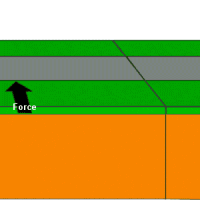What constitutes an earthquake prediction?
For the purposes of this discussion, an earthquake prediction is a statement that an earthquake of a certain size will occur in a particular area, at some time during a given time period. For the prediction to be useful, the time period needs to be relatively short, the location well-defined, and the size of the predicted earthquake accurately specified.
Why is prediction difficult?
Certain regions of the earth are noticeably more prone to earthquakes than other regions - for example: the area around the San Andreas fault in California, the West coast of South America, Japan, and the Northern part of Turkey.
By examining historic records, and making deductions based on local geology, it is generally possible to say for such a region that strong earthquakes tend to happen roughly every x years, intermediate strength quakes every y years, and small ones every z years.
Given such data, it is possible to predict, with a fair degree of confidence, the likelihood of an earthquake of a given size happening at some point during a relatively large time interval - however as that time interval is made shorter, the accuracy of any prediction rapidly decreases so that it is generally impossible to accurately forecast, for example, that a large earthquake will occur over the next 24 hours in a particular area.
A very rough analogy might be to imagine rolling a pair of dice once a day. It is easy to see that the likelihood of rolling a double-six is 1 in 36, so you would expect to get around ten of them per year - but you could not say with any confidence whether you would expect to roll a double-six tomorrow.
What causes an earthquake?
The Earth consists of a solid core, which is largely made of iron, surrounded by a thick layer of viscous, molten rock - the mantle - and floating on top of the mantle is the solid crust which makes up the land masses and ocean floors of the world. Although on a human timescale the crust appears to be stationary, it is in fact gradually moving, driven by slow but powerful currents in the mantle beneath it. The crust is fractured into several enormous sections or plates, corresponding roughly to the continents, and as these are driven by the mantle currents they tend to push against or scrape past each other. Where this happens, the crust becomes distorted and stresses build up until a critical point is reached and suddenly the layers move to a new position - this movement is felt as an earthquake.
To get a feel for the process, imagine two house bricks, one on top of the other. Gently pushing the side of the top brick will have no effect, as the roughness of the surfaces will lock the bricks together. As you push harder, a point will be reached where the top brick suddenly moves, at which point the pressure is relieved and the brick ends up stationary again, having slipped sideways a centimetre or so. If you keep up the gentle pressure then sooner or later the brick will slip again, although you will not be able to say exactly when it will slip.
Earthquakes are not restricted to the junctions between continental plates - the crust can be deformed by many processes other than friction between plates. For example, a particularly warm region of the mantle may cause an upwelling which pushes upwards on the crust from below, causing it to bulge slightly. Or the movement of ice sheets or glaciers may cause changes in the weight pushing down on a section of the crust, causing it to rise or sink accordingly. It has also been suggested that the movement of the moon around the earth causes tidal bulges in the crust which may have an impact on the buildup and release of stresses.
Where the crust is sufficiently deformed, it may develop cracks known as faults. If the crust on either side of a fault is trying
to move at different rates, then (like the house brick example above) the movement will tend to occur in a series of abrupt
jerks, each being felt as an earthquake.

What factors might help predict earthquakes?
The release of energy in a large earthquake is very abrupt, and despite careful monitoring and precise measurements of earth movements in areas prone to earthquakes, there has yet to be a scientifically confirmed prediction of a large quake. However it is conceivable that there may be changes that occur shortly before an earthquake happens, and if scientists could discover and measure these changes then it may be possible to give some warning of an imminent earthquake. Some such factors include:
- Quake swarms Sometimes several relatively low intensity earthquakes occur in succession over a period of days, weeks or months - this is known as an earthquake swarm. Swarms are often associated with the upwelling of molten rock prior to a volcanic eruption, but they are also sometimes detected before a larger earthquake strikes. However the majority of swarms do not in fact precede a powerful earthquake, and so their occurence can not be used as a reliable predictive tool. Evacuating populations unnecessarily would be expensive and disruptive, and would lead to a general lack of confidence in such warnings.
- Radon gas Radon is a naturally-occuring radioactive gas, which is created deep in the earth by the decay of other radioactive elements. It has a fairly short half-life, and so does not usually reach the surface in appreciable quantities, but it is quite soluble in water and so can be detected in springs and wells where the water emerges from deep underground. Measurements have indicated that radon levels occasionally fluctuate markedly around the time of a major earthquake - but the changes may occur after, during, or some time before the quake, or they may not occur at all.
- Disturbances in the upper atmosphere Satellite observations hint at measurable changes in the ionosphere in the days preceding the large earthquakes that hit Haiti in January 2010, and Japan in March 2011. One theory is that prior to the quake the stress in the earth's crust causes the release of radon gas. This mingles with the atmosphere and its radioactive decay causes ionisation of the air. Ions are effective 'seeds' on which atmospheric water vapour can condense to form water droplets, and this condensation causes latent heat to be released, thereby warming the surrounding air. This warmer air can be detected by satellites observing the infrared radiation it emits, and by the effects that the infrared radiation may have on the density of electrons in the ionosphere. An excess of electrons was found in retrospective analysis of satellite data following the Japanese earthquake, with the density peaking three days before the quake and returning to normal levels on the day of the quake. It is not clear whether this effect regularly precedes powerful earthquakes, and further research is ongoing.
- Animal behaviour There are many unconfirmed reports of animals acting 'strangely' in the days and hours before a large earthquake, but it is not clear how objective such reports can be. After the event it is easy to ascribe significance to something which would otherwise have been ignored and forgotten.
Have any earthquakes been successfully predicted?
The only recorded successful earthquake prediction was that of the 1975 magnitude 7.3 event in Haicheng, China. The city, of approximately 1 million residents, was ordered to be evacuated the day before the quake struck. The prediction was based on the increasing number of 'foreshocks' which were already causing some buildings to topple, and allegedly the observation of unusual animal behaviour in the region. However there is much dispute as to whether this constitutes a prediction, or merely a sensible precaution that paid off. Many other earthquakes have subsequently hit China without having been predicted.
How can earthquake warnings be issued?
When a fault slips and produces an earthquake, it generally does so deep underground. The movement at the fault produces two types of wave that travel through the earth's crust: 'P' waves, and 'S' waves. 'P' waves are compression waves, which means that the earth vibrates back and forth along the direction of travel of the wave. 'S' waves are shear waves, in which the earth vibrates from side to side relative to the direction of travel of the wave. At the epicentre - the point on the earth's surface directly above the fault - the P-waves will cause the ground to move up and down whereas the S waves will move it from side to side.
Due to the physical properties of the crust, P-waves travel faster than S-waves. If a monitoring station detects the P-waves from a large earthquake, it can issue a warning that the S-waves (which are generally more destructive in nature) will follow shortly. For locations an appreciable distance from the epicentre this can give a few minutes' warning, which may be enough time for people to move to a safe location, to switch off machinery and gas supplies, etc.
What causes a tsunami?
A tsunami, or 'tidal wave', is caused when something suddenly displaces a large volume of water. The displacement is most fequently caused by the movement of the ocean floor when it repositions itself after a large earthquake, but a tsunami can also be triggered by a large landslide into a body of water, an underwater volcanic eruption, or an event such as a meteorite impact.
A tsunami wave is very different from a normal ocean wave. Normal waves have a relatively large height to wavelength ratio - i.e. they may be high, but the peak and trough are relatively close together. When such a wave reaches the shoreline it tends effectively to 'topple over' and the crest falls back to fill the trough behind it when it rolls back down the shore. A tsunami wave on the other hand may have a relatively low height in the open ocean (generally less than a meter), but it has a very long wavelength (tens or hundreds of kilometers) and a high velocity (up to 500mph/800kph ). When a wave like this reaches shallower regions, it is forced to slow down - there is effectively nowhere for the excess water to drain away to since the trough is still far out at sea, so the wave builds up to an ever increasing height which can cause a huge amount of damage to coastal areas, and can flood locations significant distances inland.
